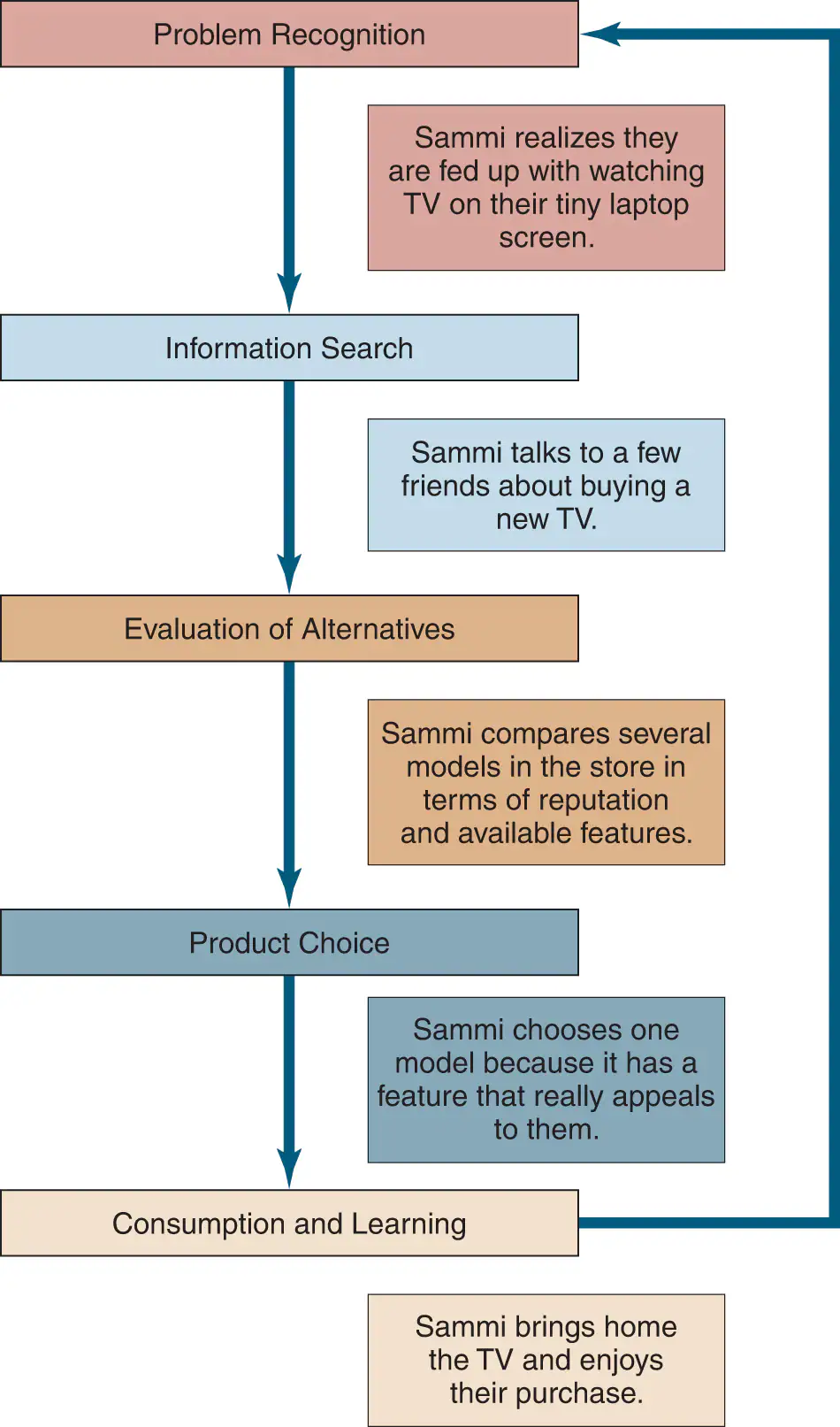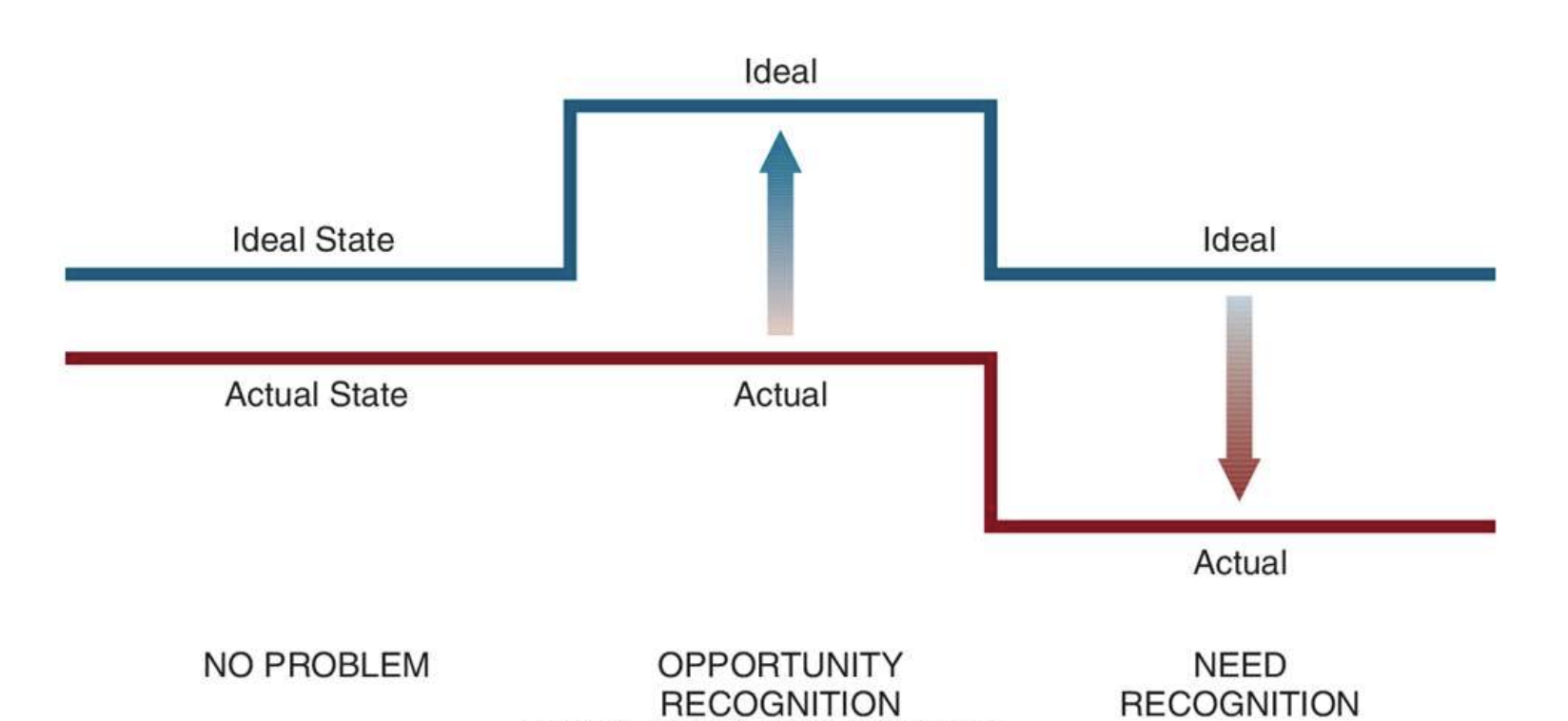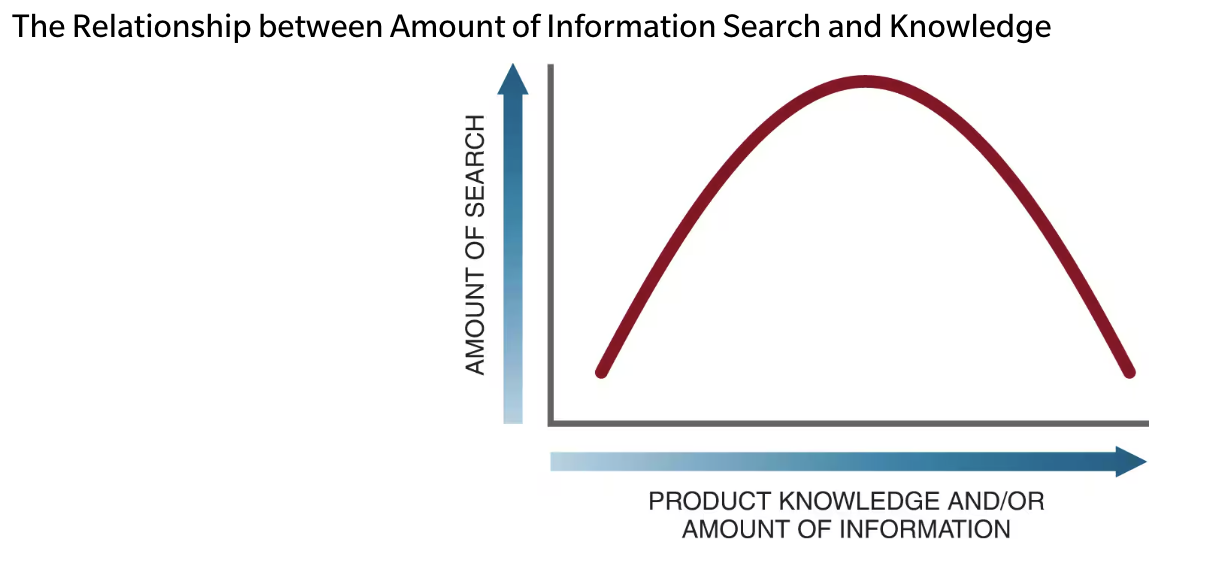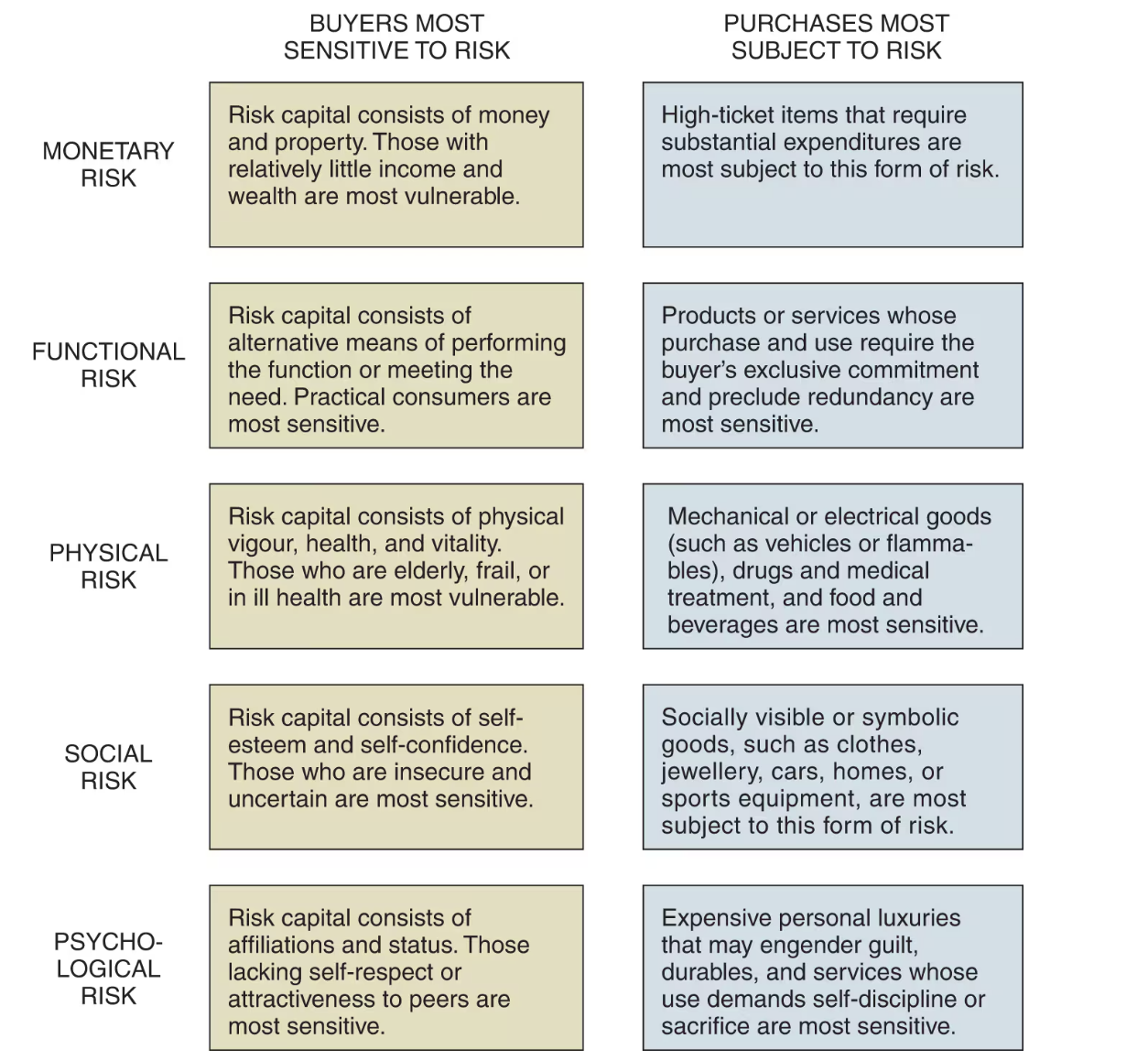Consumer behaviour - Chapter 9: Individual decision making
1/101
There's no tags or description
Looks like no tags are added yet.
Name | Mastery | Learn | Test | Matching | Spaced |
|---|
No study sessions yet.
102 Terms
Why do we make decisions as consumers?
We make decisions to solve problems
Purchase momentum
When the likelihood of buying more increases after an initial purchase
When we get "revved up" and plunge into a spending spree
Consumer hyperchoice
An overabundance of choices for the consumer, which results in the need to make repeated choices that can result in a drain a psychological energy
Consumer hyperchoice (con’t)
Too many choices may lead to dis-satisfaction with the purchase decision and reduce the likelihood to purchase in that product category again
Rational perspective
A viewpoint which sees consumers as careful analytical decision makers that try to maximize utility in purchases
The economics approach of the search process
The assumption that people collect as much data as needed to make a decision
Utility
The rewards of searching for info and the value of additional info
What should be looked at in the decision-making process?
Marketers should carefully study steps in decision making to understand how information is obtained, how beliefs are formed, and what choice criteria are specified by consumers
What can marketers do after they understand decision making process
They can develop marketing strategies which can cater to deliver types of info likely to be desired in effective formats as well as emphasize key attributes
Rational system of cognition
When people processes information analytically and sequentially using rules of logic
Experiential system of cognition
When people process information more holistically and in parallel.
Constructive processing
When consumers tailor their degree of cognitive “effort” to the task at hand
i.e when consumers devote more brain power to tasks which need more thought-out rational approaches
What do consumers do when constructive processing isn’t needed?
They’ll look for shortcuts
e.g. “just do what I usually do,” or use “gut” decisions that “automate” these choices
Behavioural influence perspective
When one’s decision is a learned response to environmental cues
e.g. An impulse buy on an item promoted as a surprise special
Extended problem solving
Initiated by a motive that is central to self-concept and comes with a high-perceived risk, and thus one tries to collect as much info as possible and weighs alternatives carefully
Limited problem solving
Buyers use simple decision rules to choose as they aren’t motivated to search for info rigorously nor evaluate alternatives
Habitual decision making
Decisions made with little to no effort, almost as if they’re routines
Experiential perspective
Consumers buy based on the sum of a product’s appeal
Compensatory rule
When we let a product make up for a flaw when it excells in another area
Simple additive rule
A type of compensatory rule where the consumer picks the option with the most positive attributes
*albeit some of attributes may not be relevant to the consumer
Weighted additive rule
The consumer takes into account the important positive attributes
Non-compensatory rule
When we reject a product based on the fact that we don’t like one or more of its traits
The lexiographic rule
The brand that is the best on the most important attribute (or the 2nd most important attribute) is chosen
Elimination-by-aspects rule
Cut-offs are imposed on the most important attributes
e.g. Someone looking for an HD TV may want at least three HDMI ports
The conjunctive rule
When one processes positive attributes by brand by cut-offs which are established by brand, and a brand is chosen if it meets all the cut-offs
The disjunctive rule
When the consumer develops acceptable standards for each attribute; these standards are usually higher than the shopper’s minimum cut-offs for attributes
The disjunctive rule (con’t)
The consumer will select something that’s exceptional in some unique way
e.g Someone shopping for a shirt may be impressed by great new colour, style, or type of fabric that exceeds their standards; if they come across 2 shirts that meet their standards, they must resort to a different rule
Decision huerstics
Mental shortcuts/rules of thumb taken during a decision-making process, which lead to quick decisions,
e.g. I buy Dempster’s Bread, the brand my dad always ate
Market beliefs
Consumer assumptions about companies, products, and stores that become shortcuts for decisions
Market beliefs (con’t)
Beliefs which send information about the association between stand-alone market concepts and are used as decision rules, and also incorporate cues as indicators of complex info
Signal
The communication of underlying qualities or traits (e.g. Values or status) via aspects which are visible to others
e.g Someone selling a used car will clean it extensively to make it look presentable to buyers
Covariation
Association among events when information is incomplete
e.g. One may form an association between quality and the length of time a manufacturer has been in business
Price-quality relationship
The assumption that higher prices mean better quality
Country of origin as a heuristic
People tend to rate their own country’s products more favourably than do people who live elsewhere
Country of origin as a heuristic (con’t)
We like to buy Italian shoes, German cars, and French luxury goods (country of origin!), as product address matters
Stereotype
A thought structure based on beliefs as opposed to evidence
How may country of origin impact consumer’s thought processes?
It can stimulate the consumer’s interest in the object to a greater degree and thus makes them think more extensively and evaluates it more carefully.
How may country of origin impact consumer’s thought processes? (con’t)
It may become a product attribute which combines with other attributes to influence evaluations
Ethnocentrism
The tendency to prefer products or people of one’s own culture over those from other countries
Choosing familiar brand names
A power heuristic where people form preferences for favourite brands and stick with them
Inertia
When a brand is purchased out of habit merely because less effort is required (low-involvement)
If another brand comes along that’s easier to purchase, the consumer won’t hesitate to switch over
Brand loyatly
Consciously choosing a preferred brand to buy regardless of all other factors
Mental accounting
When decisions are influenced in terms of how a problem is posed
Someone who paid an arm and a leg for a hockey ticket would go out in a storm to view it compared to if they got the ticket for free.
Sunk-cost fallacy
Paying for something makes one hesitant to waste it.
Hyperopia
People who are so obsessed with the future to the point they can’t enjoy the present
Loss aversion
When losing money feels worse than gaining money
Prospect theory
A model of how people make choices which finds that risk is different when one faces options involving gains vs. those involving losses
The 4 key parts of prospect theory
Reference point
Loss averse
Risk averse concerning gains, & risk seeking concerning losses
Overweight small probabilities
Reference point example
Two people wait 20 minutes to get help from a hotline. Person A will think they wasted time if they were told they’ll wait 10 mins, while person B will think they saved 10 mins if they were told they’d be waiting 30 mins
Loss averse example
Person B may be happy for a little bit about saving time, while person A may feel angry for a while about wasting time
Risk averse concerning gains & Risk seeking concerning losses
There’s a disaster, and 600 people are at risk of dying. You’re considering two rescue strategies. Strategy A: Save 200 people for sure. Or Strategy B: A one-third chance of saving 600 people and a two-thirds chance that no one will be saved
People are risk averse and prefer Strategy A, but because 400 people die, it’ll be viewed as a loss, unlike option B where there’s a chance everyone's lives will be saved. Thus option B will be preferred
Overweight small probabilities example
Lotteries, where the chance of winning is small, but people still think they’ll win
Stages in consumer decision making
Problem recognition
Information search
Evaluation of alternatives
Product choice
Consumption and learning

Problem recognition
When we recognize we have a problem and decide to solve it
The 2 ways problems can arise
Actual state - need recognition
e.g. Someone runs out of gas for their car
Ideal state - opportunity recognition
e.g. One is no longer content with how their car conveys their self-concept

Information search
When a consumer surveys the environment for appropriate data/information to make a reasonable decision

Pre-purchase search
When a consumer searches the marketplace for specific information after recognizing a need
Selective search
Efforts are more focused and efficient
What sort of searching do ‘newbies’ engage in?
“Top-down”, searches which focus less on details than the big picture
e.g. One be more impressed by the sheer amount of technical information presented on a webpage than by the actual significance of the claims made
Internal search for info
Consumers call upon background info they already know in their memory in order to gather info about product alternatives
External search for info
Obtaining information from outside sources
e.g. Ads, retailers, catalogs, friends, family, people-watching, Consumer Reports, etc.
Directed learning
When someone, on a prior occasion, has already searched for info or experienced alternatives for a product
e.g. A parent who bought a cookie for their kid may have a good idea of what cookie to buy for another kid
Incidental learning
Exposure to conditioned stimuli and observations of others results in learning material that may very well not be needed
Cybermidiary
A website or app that helps filter and organize online market information so that customers can more efficiently identify and evaluate alternatives
Maximizing
A decision-making strategy which aims to yield the best possible result
Satisficing
A decision-making strategy where the consumer settles for good enough
Satisficing (con’t)
Most consumers engage in this thought process due to a lack of time for larger items (e.g. cars or appliances), but less so for symbolic items such as clothes
Bounded rationality
A decision-making strategy where the consumer settles for good enough due to a lack of time to weigh all other options
Perceived risk
The belief that using a product may bring negative physical or social consequences
Perceived risk (con’t)
It may also be present if the decision is expensive or tricky to understand
The 5 types of perceived risks
These can be objective (physical danger) and subjective (social embarrassment)
Monetary risk
Functional risk
Physical risk
Social risk
Psychological risk

Evaluation of alternatives
Picking from the often very many available alternatives
Evoked set
Products/alternatives already in the consumer’s memory as well as prominent brands in the retail setting
Consideration set
Products/alternatives seriously considered by the consumer
Inept set
Options the consumer has decided against or don’t fit their needs
Inert set
Options which don’t come to the consumers mind at all
Why must marketers focus on getting their brands in consumers’ evoked set
Rejected brands don’t get second chances very often
How do consumer put alternatives into categories?
They evaluate attributes in terms of what they already know about the item or other similar objects (they’ll refer back to their evoked set)
Example of how consumers put alternatives into categories
One who’s evaluating a Garmin fitness watch will most likely compare it to other fitness watches rather than to a watch that simply tells the time; the category in which a consumer places the object determines the other objects they will compare it to
Why is schema (conginitive structures) important to understand
Marketers want to ensure that their offerings are correctly grouped
E.g. Tide Pods, where kids mistook them for candy instead of laundry detergent
Levels of categorization
The superordinate category - more abstract
Basic-level - the most useful in classifying products as grouped items here have lots in common yet still have alternatives
Subordinate category - often consists of individual brands

Strategic implementations of product categorization (Production Positioning)
Positioning
Identifying competitors
Exemplar products
Locating products
Positioning
When a marketer convinces consumers that a product should be considered within a given category
e.g. Orange juice being touted as a breakfast beverage
Identifying competitors
Products/services that are different on the surface but can actually compete on a super-ordinate level
e.g. Yoga and working out can both be classified as subcategories of fitness, but may not be necessarily considered substitutes of each other
Exemplar products
Brands strongly associated with a category/a brand, or a product that’s a really good example of a category, will be more familiar to consumers and will thus be recalled easier
e.g. The Kleenex brand of tissues
Exemplar products (con’t)
Moderately unusual products may stimulate more information processing and positive evaluation, as they’re neither so familiar to the point they will be taken for granted nor so discrepant that they’ll face dismissal
Location
If objects do not fit into categories, consumers’ ability to find them or make sense of them may be affected
e.g., Is a rug furniture? Where might I find frozen dog food?
Location (con’t)
The alignment between consumers’ internal product categorization and retail shelf layout dimensions heightens purchase intentions
Evaluative criteria
Dimensions used to judge merits of competing options
Spiral of complexity feature creep
Products with more options than one can realistically manage
Determinant attributes
Features which are essential to the consumer’s final choice
Post-purchase evaluation
When the consumer experiences the offering selected; is the final stage of the consumer decision process
Consumer satisfaction/dissatisfaction (Cs/d)
Determined by the general feelings/attitude a person has about an offering following its purchase; firms that have high satisfaction have bigger advantages
Expectancy disconfirmation model
When one forms beliefs about performance based on prior experience with the object or on communications about the object that imply a certain level of quality; the response can be influenced by how it aligns with expectations
Expectancy disconfirmation model (con’t)
When something performs the way we thought it would, we may not think much about it. If something fails to live up to expectations, a negative affect may result.
Expectancy disconfirmation model example
People who eat at fine dining restaurants may expect crystal clear glasses, and may be unhappy if they receive grimy glasses; though if they eat at a fast food place, they may not mind grimy glasses
Managing expectations

How may dissatisfaction be handled?
Voice response
Private response
Third-party response
Voice response
The consumer can appeal directly to the firm for compensation or do it publicly on social media
Private response
The consumer can express dissatisfaction to friends or boycott the store; is also becoming more public, with an increase in social media use and online forums for consumer expression, private responses can be quickly communicated to a more significant number of people.